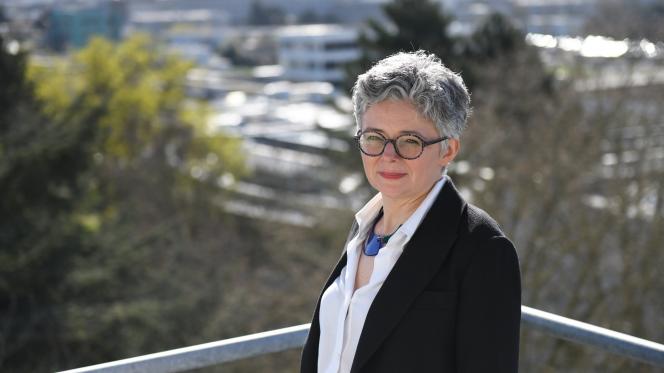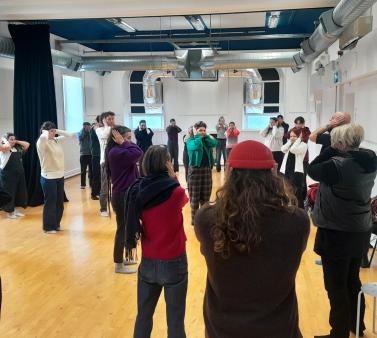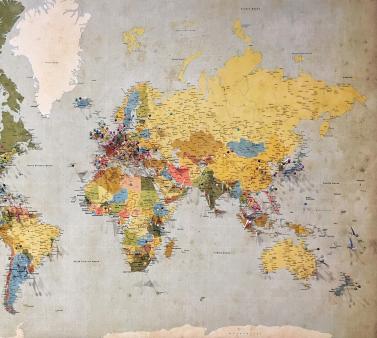
Pictured: Clarisse Bardot
As I understand it, the European Research Council provides grants for highly innovative and rigorous research projects. Could you tell me how the project STAGE corresponds to this description?
Clarisse Bardiot (CB): My project focuses on contemporary performing arts history within the broader digital humanities framework. The problem we are facing in this field is that the sources are increasingly digital. Either because they were digitized after the fact or because artists today, like many people, use their computers to draft text, send emails to communicate with colleagues, and use video recordings to capture performances, etc. Digital sources are one of the most significant challenges facing performing arts historiography. It raises complex questions concerning methodology, epistemology, and technology. We can no longer write the history of performing arts in the same way. The big question is: How can we interpret digital traces? How can we “make them talk”? What new knowledge can they bring? Within the framework of the ERC, we will be able to build an ecosystem that will be useful to the scientific community and thus produce a paradigm shift in the history of theater.
Could you describe for us some of the specific sources that you’ll be examining (archives and other sources)?
C.B. The initial corpora that I’ll be focusing on is that of the archives of the Avignon Festival, from 1947 to today, which are stored at the Bibliothèque nationale de France (BnF). Then, this corpora will be opened up to larger corpora over time to include other archives and sources of contemporary performing arts in Europe. We will also benefit from the support of the Huma-Num Research Institute dedicated to literature, the humanities and social sciences (SHS) and digital humanities. This will allow us to really scale up our results and expand our analysis. From the theater programs, we will be interested in the people who worked on the same performance. These names will form a network that we will study to understand the evolution of the collaborations within the theatre companies, and will include the jobs that take place behind the scenes such technicians. We will be able to see, for example, if a director always works with the same team or if he uses different set designers; by visualizing these networks, we will be able to observe the major changes in an artist's career and at what moments they took place. My research questions are about collaborations, the circulation of ideas, and aesthetic influences: I will be studying these in the ERC. But the methods and tools we will develop will also be helpful to other researchers working, for example, on the influence of festivals in disseminating works.
Theater differs from other art forms in that it is an ephemeral work of which only traces are kept. Among them, photographs and video recordings have a special status... Thanks to the development of algorithms based on artificial intelligence, we should be able to analyze this corpus of images to see if gestures or elements of scenography circulate from one production to another and try to build an iconology of the performing arts, a bit like Aby Warburg did for art history.
A third aspect of the project concerns the artists' creative process. Very often, when we study a creative process, we observe the artists' rehearsals. This is an important aspect, but it is not the only one. The creative process begins well before the rehearsals, if only with the director who thinks about his project, exchanges with the scenographer, collects images, sounds, materials... This leaves traces in the computers of those involved. We are going to identify a certain number of directors, and we are going to collect their hard drives and those of the members of the company, including the technicians, in order to look at what is happening on the stage as well as behind the scenes. We will also be tracking in real-time creative processes that will take place over the next five years. We will therefore have to create software to collect and analyze digital traces to understand the creative process.
How much funding will the STAGE project receive and what are some of the concrete things that you will be able to do now that you have the funding?
C.B. This funding is extremely important for the project: we will receive 2.5 million euros over 5 years. The great thing about this is that it will allow us to hire the necessary specialists and create a truly interdisciplinary team. For example, we will need to recruit post-doctoral students in artificial intelligence specializing in large corpora of images, a data scientist, researchers in the performing arts, etc. With this grant, we’ll be able to focus on this work and do so in such a way which would not have been possible otherwise.
You are the first teacher-researcher from Rennes 2 University to obtain an ERC grant. Can you tell us a little more about the commitment required in order to successfully undertake this process? And what support did you receive from the University?
C.B. Getting an ERC is a long-term project, it takes several years. But it's extremely satisfying to think about the research one would do with a 2 million euros budget. It helped me to know what I really wanted to develop in terms of a research project over the next 5 or 10 years.
In Rennes, there is a great institutional community that can assist you with work like this. I received remarkable support from the integrated regional service 2PE, a European project platform. Throughout the process, I was also lucky enough to be granted a CRCT (leave for research) and be accompanied by a CNRS delegation. As much as possible was done to help me free up time in the run-up to the official interview, and nothing would have been possible without the help of my numerous colleagues. The support of the Research and Development Office (DRV) and the professional environment at Rennes 2 overall made things easier for me.
Do you have any advice for those who want to apply for an ERC but are hesitant to do so?
C.B. Young researchers should be encouraged to apply for Starting Grants, because the further along one is in their career, the more difficult it becomes to obtain an ERC. Writing and setting up research projects can seem daunting at first, but we can be accompanied by the various support structures of the university, whether it be a research center, the DRV, the 2PE or the MSHB, there is real expertise available. I also learned a lot by being a researcher associated with other research projects. It is also important to know that the ERC rewards profiles which demonstrate an involvement in international research, hence the importance of publishing in English in international journals and contributing to international conferences.



